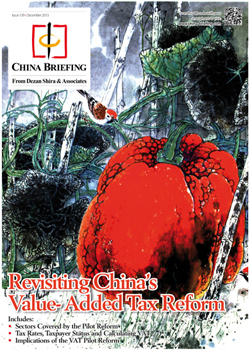New Issue of China Briefing: Revisiting China’s Value-Added Tax Reform
 Dec. 3 – The new issue of China Briefing Magazine, titled Revisiting China’s Value-Added Tax Reform, is out now and will be temporarily available as a complimentary PDF download on the Asia Briefing Bookstore throughout the month of December.
Dec. 3 – The new issue of China Briefing Magazine, titled Revisiting China’s Value-Added Tax Reform, is out now and will be temporarily available as a complimentary PDF download on the Asia Briefing Bookstore throughout the month of December.
As China’s economy develops, its tax regime has also continued to evolve as the government strives to create a system that best promotes sustainable market growth. Both business tax (BT) and value-added tax (VAT) are indirect taxes that have been implemented in China for decades. VAT income is shared between the central and local governments, with the majority going to the central government.
Meanwhile, the entire BT levied goes to the local governments. While this arrangement ensured a steady and sufficient stream of income for both the central and local governments, it also created high tax burdens for enterprises.
Prior to the reform, China’s VAT is imposed mainly on the sales and importation of goods and BT mainly on the provision of services. BT is levied on gross turnover with no deduction permitted for tax paid for the purchase of other goods or services. Meanwhile, VAT is considered a neutral tax, allowing businesses to offset certain VAT incurred in relevant purchases from their VAT liability. The two taxes are generally not mutually deductible. Replacing BT with VAT means unifying the difference in treatment between sales of goods and provision of services. This helps enhance the competitiveness of companies in the service sector and encourages them to upgrade their infrastructure.
While this change has brought about tax savings for most enterprises, some enterprises have witnessed an increase in their tax burden. Further, businesses that were previously subject to BT and now fall under the pilot reform may feel overwhelmed by this change. We attempt to demystify some of the confusions and complexities revolving around the reform by introducing the basics of the reform in this issue of China Briefing Magazine.
In this issue:
- Sectors Covered by the Pilot Reform
- Tax Rates, Taxpayer Status and Calculating VAT
- Implications of the VAT Pilot Reform
Revisiting China’s Value-Added Tax Reform is out now and immediately available as a complimentary PDF download on the Asia Briefing Bookstore for a limited time only.
Dezan Shira & Associates is a specialist foreign direct investment practice, providing corporate establishment, business advisory, tax advisory and compliance, accounting, payroll, due diligence and financial review services to multinationals investing in emerging Asia. Since its establishment in 1992, the firm has grown into one of Asia’s most versatile full-service consultancies with operational offices across China, Hong Kong, India, Singapore and Vietnam as well as liaison offices in Italy and the United States.
For further details or to contact the firm, please email china@dezshira.com, visit www.dezshira.com, or download the company brochure.
You can stay up to date with the latest business and investment trends across Asia by subscribing to Asia Briefing’s complimentary update service featuring news, commentary, guides, and multimedia resources.
Related Reading
 The 2014 Asia Tax Comparator
The 2014 Asia Tax Comparator
In this issue of Asia Briefing Magazine, we examine the different tax rates in 13 Asian jurisdictions – the 10 countries of ASEAN, plus China, India and Hong Kong. We examine the on-the-ground tax rates that each of these countries levy as well as residency triggers, available tax incentives for the foreign investor, and important compliance issues.
 An Introduction to Tax Treaties Throughout Asia
An Introduction to Tax Treaties Throughout Asia
In this issue of Asia Briefing Magazine, we take a look at the various types of trade and tax treaties that exist between Asian nations. These include bilateral investment treaties, double tax treaties and free trade agreements – all of which directly affect businesses operating in Asia.
 The China Tax Guide: Tax, Accounting and Audit (Sixth Edition)
The China Tax Guide: Tax, Accounting and Audit (Sixth Edition)
This edition of the China Tax Guide, updated for 2013, offers a comprehensive overview of the major taxes foreign investors are likely to encounter when establishing or operating a business in China, as well as other tax-relevant obligations. This concise, detailed, yet pragmatic guide is ideal for CFOs, compliance officers and heads of accounting who need to be able to navigate the complex tax and accounting landscape in China in order to effectively manage and strategically plan their China operations.
- Previous Article China Turns to Romania for Meat Supplies
- Next Article China Issues Financial Reform Guidelines to Boost Shanghai Free Trade Zone









